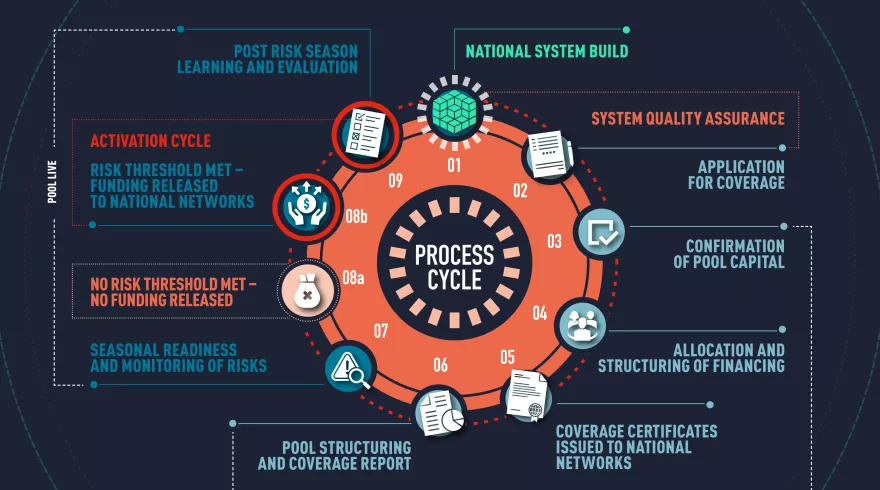HNPW 2024 | Anticipatory Action and Disaster Risk Management: Impact, Opportunities, and Way Forward
On May 8, 2024 as a part of Humanitarian Networks and Partnerships Week, Start Network hosted a session to unpack the role of anticipatory action in disaster risk management, and how different stages of the crisis management cycle interact and can positively reinforce one another to have more timely, adequate, and dignified responses.
Read on to find out the key takeaways from the session.
Published:
Time to read: 5 minutes
Anticipatory action in the humanitarian system continues to gain momentum. In 2023, the Grand Bargain has included anticipatory action as a core element of its work. While this is a great sign of the system shifting to more proactive approaches, it is paramount to understand the scope, reach, opportunities and limitations of anticipatory action, and how it is part of the crisis management cycle.
This session, ‘Anticipatory Action and Disaster Risk Management: Impact, Opportunities, and Way Forward’ unpacked the role of anticipatory action in disaster risk management, and how different stages of the crisis management cycle interact and can positively reinforce one another to have more timely, adequate and dignified responses.
The session was moderated by Anna Farina (Head of Crisis Anticipation and Risk Financing at Start Network), and panellists included Lydia Poole (Associate Director for Policy & Evidence at the Centre for Disaster Protection), Gloria Womitso (Underwriting Manager/Humanitarian Lead at Africa Risk Capacity Limited), Sabir Ali (Programme Coordinator at Rural Development Foundation of Pakistan), and Gantsetseg Gantulga (Coordinator Anticipatory Action at the International Federation of Red Cross and Red Crescent Societies).
Key Takeaways:
Start Ready is Start Network’s financing mechanism which pre-positions funding for crises that happen with regular and predictable patterns of recurrence, which launched in late 2021, with the first risk pool going live in May 2022. As of April 2024, Start Ready has disbursed more than £7.5 million and reached over 340,000 people in seven countries for eight climate hazards.
Pre-arranged financing is a crucial element of anticipatory action and supporting more proactive disaster risk management responses. Lydia Poole from the Centre for Disaster Protection explained that pre-arranged financing still represents a very small proportion of total crisis financing – 2.2% of crisis financing was pre-arranged across the five-year period 2017-2021 – though it is growing in recent years. Even smaller, is the amount of humanitarian funding for anticipatory action 0.2% in 2021.
-
2.2%
of total crisis financing was pre-arranged from 2017-2021
0.2%of humanitarian funding in 2021 was for anticipatory action

One of the key findings emerging from this report was that pre-arranged financing...is really concentrated in high-income, upper-middle income and lower-middle income countries. High-income and upper-middle income countries, received 43% of that funding, lower-middle income countries 38%, and low-income countries just 3.7% of pre-arranged financing between 2017-2021...Anticipatory action is a really important part of the mix, and it really shows this wider trend that it is heavily concentrated in low-income countries and also in fragile settings. So, if you care about meeting the needs of the most vulnerable people in a timely fashion, you should definitely care about anticipatory action.Lydia Poole
Insurance mechanisms are increasingly a way to provide pre-positioned financing that is ready to be released at the time of a crisis.

Insurance is important for disaster risk management as it is able to complement other funding and actions. Africa Risk Capacity is a disaster risk management instrument in Africa and we cover floods, droughts, and cyclones, by working with African Union members states and with humanitarian partners.Gloria Womitso
At the community level, it is important to coordinate anticipatory actions with various actors including civil society, government departments, disaster management authorities, and at-risk populations. Sabir Ali from Rural Development Foundation of Pakistan described the difference he has seen in Pakistan over the past two years of having communities involved in the designing, decision-making, and planning of anticipatory action, in order to protect themselves.

When you involve the community in the design process and also the implementation process, it becomes more impactful. Partnerships and collaboration are key to have impact in local communities.Sabir Ali
The Early Warnings for All Initiative launched by the UN Secretary General in March 2022, has four pillars which contribute to the overall early warning value chain - Pillar 1: Disaster Risk Knowledge; Pillar 2: Detection, observations, monitoring, analysis and forecasting of hazards; Pillar 3: Warning dissemination and communication; Pillar 4: Preparedness to respond.

If you think about the different pillars, different organisations are working in [each]. The four pillars need to work consistently and with complementarity and interlinkages.”Gantsetseg Gantulga
For example, the national societies of the Red Cross and Red Crescent Movement’s approach to preparedness is to do so in a holistic way. Their ‘Preparedness to Effective Response’ approach has 37 components. Gantsetseg Gantulga highlighted the various considerations needed when thinking about preparedness including (but not limited to) multi-hazard contexts, using risk information effectively, operational capacity and capacity strengthening, support services, and funding.
The next steps to improve anticipatory action and disaster risk management overall include:
-
Greater coordination among sectors (climate, development, humanitarian) and developing a common language to support this coordination;
-
Building early warning systems that are able to effectively reach those in need;
-
Better data for forecasting and prediction including greater integration of traditional knowledge; and
-
Increased financing, particularly ‘fuel money’ (*longer term committed funding for the implementation of anticipatory action).

“It is important to switch from a mentality where donors want to reach people to a mentality where they want to protect people. [This means donors should] feel like their funding is already spent and in action at the moment that it is allocated to disaster risk financing systems - because [the money] [is] already protecting people, even if the disaster has not happened yet.”Anna Farina

